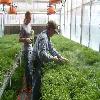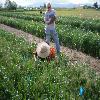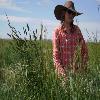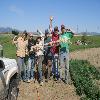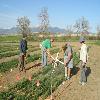Role of wheat variety, weed biotype, and stress on virus transmission and crop-weed competitive interactions
Links and/or abstracts:
2010 ESA meting. Direct and interactive effects of plant stressors on winter wheat yields and crop-weed
competition
Zachariah J. Miller, Fabian Menalled, Mary Burrows, and Noelle Orloff.
Background/Question/Methods. Crop losses associated with biological stressors such as weeds and disease may depend upon abiotic conditions (e.g. resource availability) as crop-weed interactions are mediated through shared resource pools and resource availability can alter plant-disease interactions. Consequently, the combined effects of these stressors on crop performance likely differ from the sum of each effect. In a field experiment, we studied the effects of resource availability (soil nitrate), crop density, weed species identity (Setaria viridis, Avena fatua, Bromus tectorum) and density, and the presence of a generalist pathogen, Wheat Streak mosaic virus (WSMV), on winter wheat (Triticum aestivum) yield and weed seed production. Leaf samples from individual wheat and weed plants in inoculated plots were used to estimate WSMV incidence and to determine the effects of soil nitrate level on WSMV infection. Weed and crop densities and seed production were measured at both the plot and subplot levels and treatment effects analyzed with GLM and mixed linear models respectively.
Results/Conclusions WSMV infection rates varied significantly among species and soil nitrate level. Wheat showed the highest infection rates (44.6% infected) followed by A. fatua (11.2%). The other weed species were rarely infected. In wheat, WSMV incidence rose from 22% at the lowest soil nitrate level (10-18 kg/ha) to nearly 70 % in the highest nitrate level. Crop yield was reduced by B. tectorum but not by other weed species. While yield increased with soil nitrate levels, WSMV inoculation and increasing B. tectorum density significantly reduced yields only at soil nitrate levels above 26 kg/ha. Yield reductions at higher soil nitrate levels associated with WSMV eliminated yield benefits of increased soil fertility. B. tectorum seed production increased by a factor of 3 when soil nitrate level was greater then 25 kg/ha. WSMV inoculation shifted weed seed production threshold response to a higher nitrate level by reducing weed production by over 70% at intermediate nitrate levels. Additionally, WSMV inoculation also appeared to reduce crop suppression of weed seed production. These results suggest that crop-weed interactions can not be understood in isolation as crops in production fields are faced with multiple stressors that can alter impacts of weeds on yield and weed spread.
2009 WSSA meting. Nitrogen availability and distance from row modifies competitive interactions between
downy brome (Bromus tectorum) and winter wheat.
L. Noelle Orloff, Zach J. Miller, Fabian D. Menalled and Jane M. Mangold
Downy brome competition and plant available nitrogen have been shown to affect winter
wheat yields. We conducted a field experiment to determine the potential effects of
winter wheat density on downy brome performance over a range of nitrogen availabilities.
Competitive neighborhoods were established using 0.1 meter rings. Within the rings,
we measured individual downy brome distance from the wheat row, growth rates, biomass,
and seed production, and characterized the competitive environment using density and
canopy cover measurements for winter wheat and all additional downy brome. We calculated
individual downy brome performance as a function of nitrogen availability, individual
downy brome estimated volume, downy brome distance from wheat row, and competition
from plants in the competitive neighborhood. While at low nitrogen availabilities
it was not possible to predict downy brome performance, at medium to high soil nitrogen
concentrations a non-linear relationship between distance from row and downy brome
performance was observed. At moderate to high nitrogen availabilities downy brome
is suppressed within the wheat row and individual performance increases as distance
from the row increases. These results suggest that at moderate to high nitrogen levels,
winter wheat density could be manipulated to reduce downy brome competitive ability.
Click on an image to view as a slideshow.

